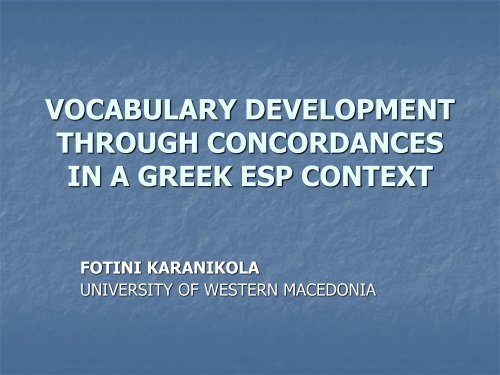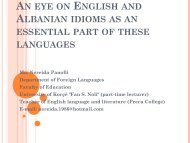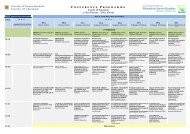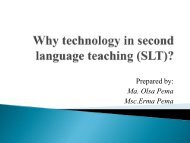Oral Presentation
Oral Presentation
Oral Presentation
Create successful ePaper yourself
Turn your PDF publications into a flip-book with our unique Google optimized e-Paper software.
VOCABULARY DEVELOPMENT<br />
THROUGH CONCORDANCES<br />
IN A GREEK ESP CONTEXT<br />
FOTINI KARANIKOLA<br />
UNIVERSITY OF WESTERN MACEDONIA
TOPIC AND MAIN AIM OF THE PAPER<br />
• This pilot project deals with an alternative and more<br />
motivating way of approaching vocabulary instruction<br />
within a Greek ESP context, with the help of a computer<br />
software (concordancer), which analyzes electronically<br />
gathered reading texts (corpora) for the discovery of<br />
regular patterns and lexical sets, an approach called<br />
Data-Driven Learning (DDL).<br />
• This approach, which has been decided after a needs<br />
analysis, is quite promising since it integrates technology<br />
to promote learners’ motivation and vocabulary<br />
development.
SAMPLE AND THE PARTICULAR TEACHING<br />
CONTEXT<br />
• The participants of this advanced ESP course are students of the first<br />
semester, 80% female (40 girls) and 20% male (10 boys) of the University<br />
of Western Macedonia in Florina, (Department of Primary Education, Faculty<br />
of Pedagogy), their age is from 18-39 years old and some of them have got<br />
the first and the proficiency certificates.<br />
• The English language is a core subject in the two semesters of the<br />
department which engages students in reading relevant authentic materials,<br />
helping them increase both linguistic and academic skills, enhance their<br />
subject knowledge and develop English language skills.<br />
• The teaching methods used are traditional teacher centered lectures,<br />
vocabulary is taught via translation and synonyms, whereas assessment<br />
methods are written exams and mini assignments.<br />
• The motivation is very low since most of them dislike studying and<br />
learning ESP vocabulary in the traditional way.<br />
• Having looked at the problematic context of the Greek reality and in order to<br />
introduce an alternative teaching approach the teacher decided to<br />
conduct a needs analysis research through the means of questionnaires.
MATERIAL DESIGN<br />
NEEDS ANALYSIS QUESTIONNAIRE<br />
• Quoting Sifakis (2000, p. 136) “needs analysis is the process where<br />
the profile of a particular teaching situation (involving<br />
learners, materials and actual lessons) is drawn”.<br />
• By determining students needs is a movement towards a learnercentered<br />
instruction, where teaching should be designed to meet<br />
the precise needs of the learner.<br />
• The particular questionnaire consists of four conceivable parts,<br />
each one covering different needs and providing different<br />
information.<br />
• Part A generally focuses on respondents’ personal facts.<br />
• Part B seeks information about respondents’ present level of the<br />
target language, their attitude towards English course and their<br />
target language needs.<br />
• Part C explores difficulties and deficiencies related to all four skills in<br />
learning vocabulary.<br />
• Part D is regarded as the most crucial as it investigates valuable<br />
information concerning learners’ preferred class activities, teaching<br />
experiences so far and their learning/ teaching needs.
RESULTS OF THE QUESTIONNAIRE<br />
• The total number of questionnaires administered to students was 40<br />
but only 23 were completed and returned (so a limitation of a small<br />
sample could not be neglected).<br />
• The detailed quantitative data have been analyzed with the SPSS<br />
statistical program and the results are presented in a combined way<br />
of tables and bars charts (in a more convenient and reader friendly<br />
way).<br />
• The most prevalent results were that half of the students were<br />
holders of the proficiency degree and they wanted to be in contact<br />
with the English language (47, 8%), which indicates a positive and<br />
promising attitude towards learning English.<br />
• They were also interested in terminology acquisition although they<br />
had great difficulties in reading vocabulary with relevant<br />
terminology. (47, 8%)<br />
• They disliked traditional ways of vocabulary instruction and activities<br />
(69, 6%), they liked working in groups (47, 8%) and there was<br />
obvious favor in the use of the computer lab (95, 7%)!<br />
• Athough the majority had never heard about concordances (78,<br />
3%), they believed that collocations and studying whole sentences<br />
would offer better results in their vocabulary development and<br />
acquisition (47, 8%).
CHOOSING SOFTWARE<br />
• The writer after having conducted an extended internet<br />
research she decided to use WordSmith Tools 5 concordancer<br />
for the particular project. This freeware software package is<br />
published by the Oxford University Press, was developed by<br />
Mike Scott, it was downloaded from<br />
http://www.lexically.net/wordsmith/index.html and is<br />
accompanied by a thorough and informative manual.<br />
• This program can create concordances, perform keyword<br />
analyses and compile word-frequency lists.<br />
• The Wordlist tool will let the students see a list of all the<br />
words or word-clusters in a text and to identify the contextual<br />
information necessary to disambiguate words.
A concordance looks something like this:
COMPILING THE CORPUS<br />
• Being influenced by Aston (2002), who supports that these corpora can be<br />
specifically targeted to the learners’ knowledge and concerns, the teacher<br />
decided to use the internet as a researching and retrieving source.<br />
• She had gathered and saved 41 thematically related downloadable articles<br />
containing 600-3000 words each, so all together this experimental corpus<br />
contains approximately 60.000 words and as the titles of the stored texts<br />
suggest, they concern pedagogical and methodological issues.<br />
• She also took into consideration Zhang’s (2008) suggestions about selfbuilding<br />
a mini corpus[1] and followed Tribble and Jones’s (1990, p.14)<br />
suggestions that “a corpus of 50.000 words should be very useful for<br />
classroom purposes”.<br />
• According to Lewis (2000), cited in Watson Todd (2001), this is a corpus of<br />
specific genre of text, being compiled by academic and newspaper/journal<br />
feature articles.<br />
•<br />
[1] Namely a mini-corpus should be learner-oriented (the texts collected<br />
must be of learners interest or concern), understandable and difficulty<br />
suitable (so as students will not be frustrated by the non comprehensible<br />
instances of the corpus. It should be fully analyzable, easy to become<br />
familiar with and clearly patterned (collocations and other words
IMPLEMENTATION<br />
• THE STAGES (PRE-/WHILE-/POST) OF THE<br />
PROCEDURE FOLLOWED DURING THE PROJECT<br />
• OBJECTIVE : to enhance vocabulary<br />
development and exploitation by using authentic<br />
language<br />
• TEACHING PROCEDURE >>>>AIMS >>>>TIME
• Activity A<br />
• Sts are divided into two groups<br />
and work in pairs.<br />
• They read the activity sheet and<br />
follow the instructions to get<br />
acquainted with the search and<br />
retrieval techniques used in<br />
concordance software. They type<br />
the word DISCIPLINE and retrieve<br />
the concordance list and save it.<br />
They observe the collocation sets<br />
and consult the stored texts by<br />
double clicking on the KWIC<br />
• ---------------------------------------<br />
• Activity B<br />
• Sts observe and study the<br />
concordaner list concerning the<br />
various meanings of the retrieved<br />
word.<br />
PRE - PHASE<br />
• To practice computer and<br />
concordance skills<br />
• To raise the interest and<br />
motivation to work with authentic<br />
material data<br />
• To encourage group/pair work<br />
• (15 MIN)<br />
• -----------------------------------------<br />
• To focus<br />
patterns<br />
on specific lexical<br />
• To develop interpretative skills<br />
• To convey meaning<br />
multiword patterns<br />
from<br />
• To teach text analysis techniques<br />
• To observe habitual collocations<br />
and discover new meanings<br />
• To engage sts in active<br />
participation in the process of<br />
learning<br />
• To provide<br />
examples<br />
sts with natural<br />
(10 MIN)
• Activity C<br />
• Sts write down the examples and infer<br />
meanings<br />
• -----------------------------------------------<br />
• Activity D<br />
• Sts deal further with collocations and<br />
colligations<br />
• -----------------------------------------------<br />
• Activity E<br />
• Sts look up the word in an on line<br />
dictionary. They note down useful<br />
information about the use of the word.<br />
They can also consult the dictionary’s<br />
audio file.<br />
• -----------------------------------------------<br />
• Activity F<br />
• Sts complete the gap filling task<br />
WHILE - PHASE<br />
• To capture specialized phraseology<br />
• To break away from rule-based<br />
approach into the DDL approach<br />
• To consult relevant concordance<br />
material through direct access to the<br />
corpora<br />
• To analyze data and draw conclusions<br />
(10 MIN)<br />
• ----------------------------------------------<br />
• To demonstrate features of<br />
vocabulary, typical collocations and<br />
grammar points<br />
• To promote sts construction process<br />
• To relate words to syntax (10 MIN)<br />
• ----------------------------------------------<br />
• To become critical of dictionary entries<br />
• To engage sts into discovery,<br />
divergent and serendipity learning<br />
• To base on sts own explorations<br />
(15 MIN)<br />
• -----------------------------------------------<br />
• To stimulate sts cognition<br />
• To build sts competence<br />
• To make specific personal<br />
contribution to the tasks (10 MIN)
POST - PHASE<br />
• Activity G<br />
• Sts search the web for<br />
the given word, they skim<br />
and scan related texts<br />
and save them on their<br />
computers for further<br />
use.<br />
• To bring sts a sense of<br />
responsibility<br />
• To turn<br />
researchers<br />
sts into<br />
• To become more<br />
independent readers<br />
• To analyze and interpret<br />
data<br />
• To encourage sts to act<br />
as the producers of<br />
research rather than<br />
passive receptacles<br />
• (20 MIN)
• Entries for discipline use [translation] definition [examples]<br />
• as noun1. discipline noun a branch of knowledge: "in what discipline is<br />
his doctorate?"; "teachers should be well trained in their subject";<br />
"anthropology is the study of human beings"<br />
See also: subject , subject area , subject field , field , field of study ,<br />
study , branch of knowledge<br />
2. discipline noun training to improve strength or self-control<br />
3. discipline noun the trait of being well behaved: "he insisted on<br />
discipline among the troops"<br />
4. discipline noun a system of rules of conduct or method of practice:<br />
"he quickly learned the discipline of prison routine" or "for such a plan<br />
to work requires discipline"<br />
5. discipline noun the act of punishing: "the offenders deserved the<br />
harsh discipline they received"<br />
See also: correction<br />
• as noun, uncountable; countable6. discipline noun, uncountable;<br />
countable 訓 練 , 鍛 鍊 , 磨 練 training, esp of the mind and character,<br />
aimed at producing self-control, obedience; method by which training<br />
may be given: 1. Strict discipline is imposed on army recruits. 2. Yoga<br />
is a good discipline for learning to relax. 新 兵 受 到 嚴 格 的 訓 練<br />
See also: training , drill , drilling , schooling , indoctrination , rigor ,<br />
enforcement of rules , diligent exercise , practice , preparation<br />
• as verb7. discipline verb train by instruction and practice; esp.<br />
to teach self-control: "Parents must discipline their children"<br />
See also: train , check , condition
BENEFITS OF CONCORDANCERS AND<br />
CORPORA IN L2 TEACHING AND LEARNING<br />
• Corpus is a gold mine of authentic language use and mining that<br />
through KWIC concordances can provide students with multiple<br />
contexts, from which new vocabulary can be learned.<br />
• Language students deduce the meaning and the patterns of the<br />
word are immediately clear if students analyze several examples of<br />
the word.<br />
• What the concordancer does is to “make the invisible visible” by<br />
locating or discovering collocations. (Tribble, 1996, p.11)<br />
• Learners play the role of a researcher who explores the use of<br />
language through investigating an authentic corpus. (Johns and<br />
King, 1990)<br />
• Concordances help to implement a student-centered approach<br />
which empowers the learners to work on an autonomous basis.<br />
(Gonzalez, 1999)<br />
• Language learners can benefit from teaching materials promoting<br />
inductivity, authenticity and learner responsibility for<br />
learning. (Stevens, 1991 a)
POSSIBLE LIMITATIONS<br />
• Some students may become quickly overwhelmed and<br />
demotivated if they are provided with too much data.<br />
• The vocabulary would often be beyond their level ability.<br />
• Preparation and development of the material takes a lot<br />
of time.<br />
• Students need to be trained so as to use the resources<br />
correctly.<br />
• Corpus –based pedagogical materials are not widely<br />
used by teachers and learners.
EXPECTED OUTCOMES OF THE PROPOSAL<br />
• Teachers can use concordances to find examples of authentic<br />
usage to demonstrate features of vocabulary, typical collocations<br />
and they can generate exercises based on examples drawn from a<br />
variety of corpora.<br />
• Students based on their own explorations can discover rules,<br />
new meanings and draw inferences from lexical features by<br />
searching for key words in context, turning themselves into<br />
researchers.<br />
• They can be more active, motivated and autonomous in their<br />
vocabulary learning as they observe habitual collocations and<br />
relate words to syntax.<br />
• They can use the gathered authentic linguistic information for<br />
error analysis or as an aid to improve their reading and writing<br />
skills.<br />
• It is hoped that educators who plan to run or are currently running<br />
a similar technology mediated course can benefit from this<br />
example of teaching.
• THANK YOU !










